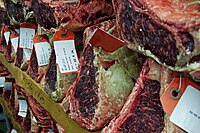
Photo from wikipedia
Two-dimensional quantitative nuclear magnetic resonance (2D qNMR)-based metabolomics was performed to understand characteristic metabolic profiles in different aging regimes (crust from dry-aged beef, inner edible flesh of dry-aged beef, and… Click to show full abstract
Two-dimensional quantitative nuclear magnetic resonance (2D qNMR)-based metabolomics was performed to understand characteristic metabolic profiles in different aging regimes (crust from dry-aged beef, inner edible flesh of dry-aged beef, and wet-aged beef striploin) over 4 weeks. Samples were extracted using 0.6 M perchlorate to acquire polar metabolites. Partial least squares-discriminant analysis showed a good cumulative explained variation (R2 = 0.967) and predictive ability (Q2 = 0.935). Metabolites of crust and aged beef (dry- and wet-aged beef) were separated in the first week and showed a completely different aspect in the second week via NMR-based multivariable analyses. Moreover, NMR-based multivariable analyses could be used to distinguish the method, degree, and doneness of beef aging. Among them, the crust showed more unique metabolic changes that accelerated proteolysis (total free amino acids and biogenic amines) and inosine 5′-monophosphate depletion than dry-aged beef and generated specific microbial catabolites (3-indoxyl sulfate) and γ-aminobutyric acid (GABA), while asparagine, glutamine, tryptophan, and glucose in the crust were maintained or decreased. Compared to the crust, dry-aged beef showed similar patterns of biogenic amines, as well as bioactive compounds and GABA, without a decrease in free amino acids and glucose. Based on these results, the crust allows the inner dry-aged beef to be aged similarly to wet-aged beef without microbial effects. Thus, 2D qNMR-based metabolomic techniques could provide complementary information about biochemical factors for beef aging.
Journal Title: Molecules
Year Published: 2020
Link to full text (if available)
Share on Social Media: Sign Up to like & get
recommendations!